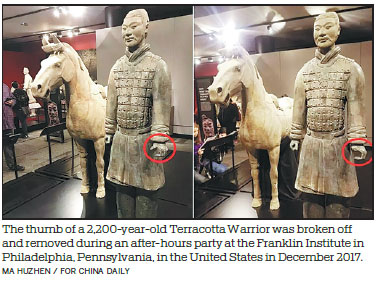Mistrial declared in US case of Terracotta Warrior's missing thumb
He broke off the thumb of a Terracotta Warrior and then he got a break of his own - in court.
A mistrial was declared on Tuesday in the case of a Delaware man charged with snapping off a digit from one of China's revered cultural relics at a Philadelphia museum in December 2017.
After deliberating for 11 hours, the jury of seven men and five women was unable to reach a verdict in the trial of Michael Rohana, 25, who was attending a Christmas-themed "ugly sweater party" at the Franklin Institute when he entered a closed exhibit of the ancient statues.
US District Judge Petrese B. Tucker dismissed jurors as Rohana's family and supporters shook hands and hugged in the courtroom.
If convicted, Rohana could have faced a maximum term of 30 years in prison, up to three years of supervised release and a $750,000 fine, according to the US Attorney's Office for the Eastern District of Pennsylvania.
Prosecutors said they would decide by May 15 whether to retry the case.
Authorities said Rohana took photos while posing next to the 2,200-year-old statue known as The Cavalryman, valued at $4.5 million, then removed the statue's left thumb and put it in his pocket. The incident was captured on surveillance cameras.
Though Rohana, a shoe salesman, did not deny that he broke off the thumb and took it home, the jury deadlocked on charges of theft and concealment of an object of cultural heritage, The Philadelphia Inquirer reported.
Rohana's lawyers had argued he wasn't charged under the proper law.
"These charges were made for art thieves - think like Ocean's Eleven or Mission: Impossible," federal public defender Catherine C. Henry said in closing arguments, according to the Inquirer. Rohana "wasn't in ninja clothing sneaking around the museum. He was a drunk kid in a bright-green ugly Christmas sweater."
In her closing, Assistant US Attorney K.T. Newton dismissed those arguments.
"Michael Rohana deliberately broke the thumb," Newton said. "He took it out of the Franklin Institute and he took it home. That is theft. That is stealing."
Rohana testified that as soon as he broke the thumb, he knew it was a mistake. He slipped the statue piece into his pocket and bolted from the room, he said.
"Every time I see this video now, I'm trying to figure out, 'What was going through your mind? What were you thinking?'" he testified. "I don't know how I could have been so stupid."
After the FBI's Art Crime Team identified Rohana as the suspect and confronted him at his residence, he confessed and handed over the thumb, which he had kept in a desk drawer, the Inquirer reported.
The Franklin Institute said it has taken steps to avoid similar situations.
The thumb was returned last year to officials in Northwest China's Shaanxi province.
The Cavalryman is one of the few fully restored Terracotta Warriors among the thousands discovered by a farmer in 1974 in the tomb of China's first emperor, Qin Shi Huang (259-210 BC).
The Chinese government strictly regulates research and restoration of the statues and has prohibited their purchase or sale. The Franklin Institute was one of two US museums that Chinese officials allowed to host a traveling exhibit.
The Shaanxi Cultural Heritage Bureau said in April 2018 that cultural exchanges between China and the US would not be affected by the incident, but security measures for high-value cultural relics would be improved.
Hong Xiao in New York and The Associated Press contributed to this story.
williamhennelly@chinadailyusa.com

(China Daily 04/12/2019 page1)


















